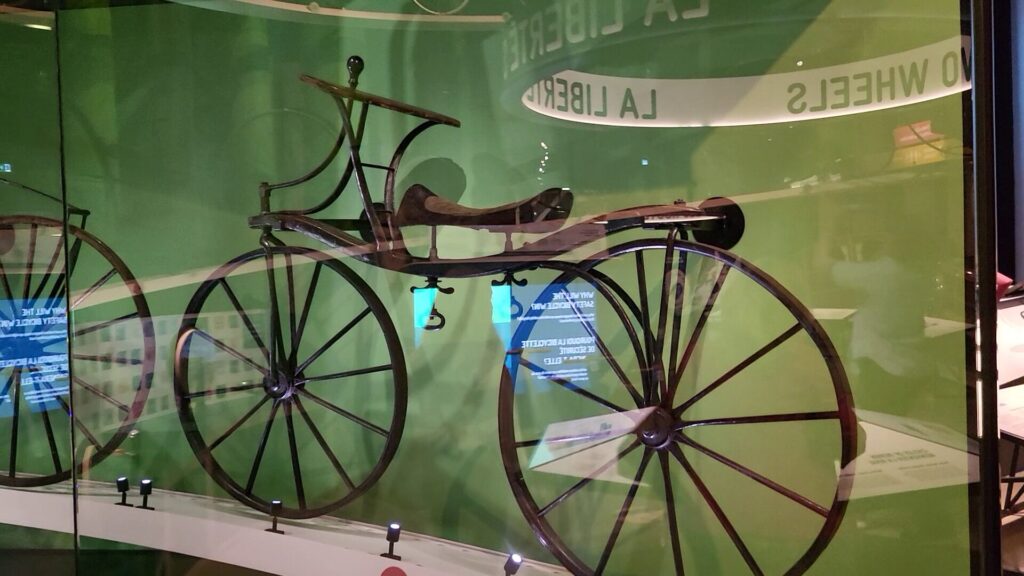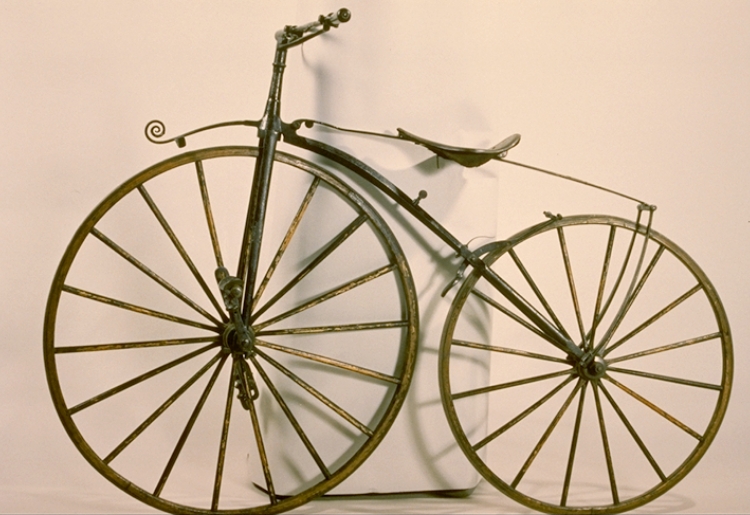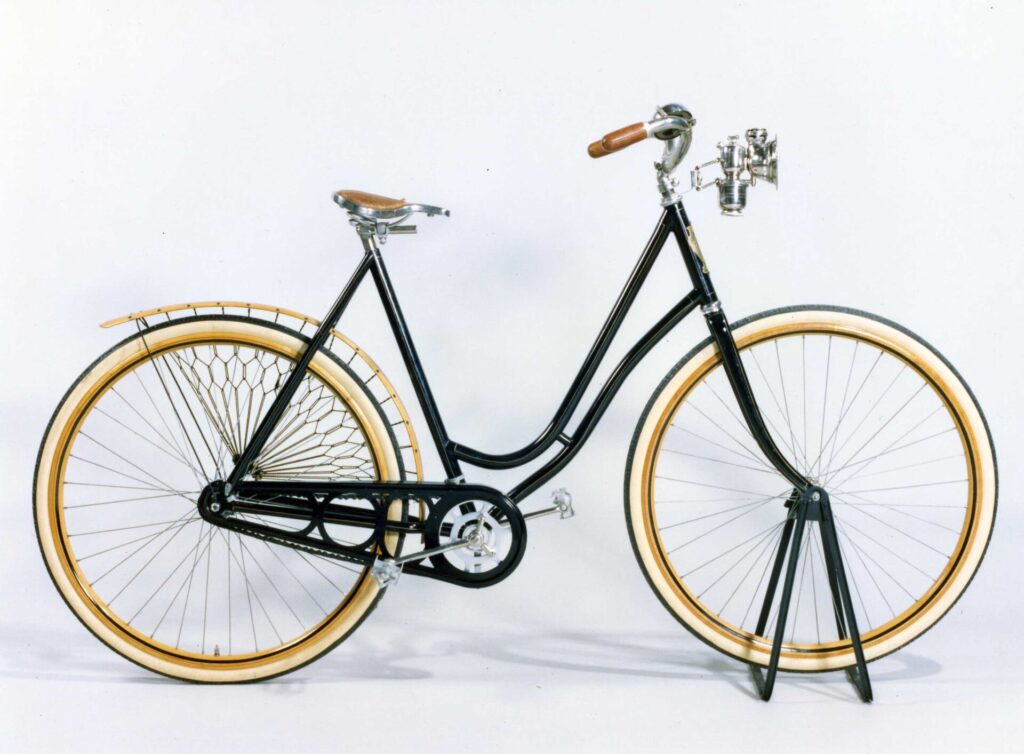The rush of wind in your face, the grinding of gears, and that unique surge of adrenaline and freedom from riding a bike starts early and lasts a lifetime. With approximately 16 percent of Canadians claiming to cycle at least once a week, it remains a timeless form of exercise, transport, and leisure that is still relevant today.
Although bicycles are beloved by many, they were not always the most comfortable or safest way to get around. To explore the history of bicycling, CAA recently visited the Canada Science and Technology Museum to chat with head curator Dr. Emily Gann.
The Hobby Horse
Claims to the design of the first bicycle range from Renaissance Italy to 18th Century Japan, the first documented one was drawn up in 1818 by German Baron Karl von Drais.

The Draisienne, also nicknamed the Hobby Horse or Dandy Horse, lacked the pedals, brakes, and nearly any safety measures we associate with the vehicle today. The Hobby Horse was propelled by skipping along and gliding with it for short distances. Ingenium’s Hobby Horse was made by English coachmaker Denis Johnson in 1818. Not the most efficient means of transportation, it was thought of as a leisurely activity for the affluent, notes Gann.
“At this point in time, cycling, because it was artisanal made and costly, was an activity for the upper class, and at that point in time, upper-class men.”
The Velocipedes

Innovation continued to roll throughout the 19th century, leading to various changes and additions to Karl von Drais’s original design. As the years passed, some of the signature elements of a modern bike began to fall into place, but still had a long road to go.
The Velocipedes, or what Gann calls the ‘Bone Shaker,’ truly earned its moniker regarding old-school bikes. Drawn up in the 1860s in France, the machine is part of the first generation of bicycles notable for its addition of pedals, a curved frame and mega-sized wheels. While it was certainly more mobile than the Hobby Horse, it still had some way to go regarding safety and comfort, Gann explains.
“You now have a pedal – you’re sitting, but you’re powering through. (It has) no chains, no gears, no speed or resistance. This one is often referred to as the Bone Shaker because it was incredibly uncomfortable,” she says.
“There’s nothing really to absorb much of the shock. You do have a bit of absorption in the seat, but you also have to think that roads were not what they are today.”
Despite all that, the Velocipedes dominated the early world of cycling. Although they are unlikely to be seen on modern city streets, the fundamental mechanisms were still utilized in railroad tools until the 1940s.
The Penny Farthing
The most eye-catching design for a modern cyclist, the Penny Farthing, or ‘High Wheel,’ upped the ante in wheel size. With an average front wheel diameter of 1.5 meters, these eye-catching cycles have gone down in history for their over-the-top design.

As cartoonish as the Penny Farthing may seem, looks can be deceiving. The iconic cycle brought a unique form of utility because the circumference of its enormous front wheel meant that riders could cover a greater distance with less pedalling. On the other hand, the seat atop the oversized wheel required agility to hop on.
“You can’t just get on it from a stationary position,” says Gann.
“You need to have momentum, and then you will see this little step. So you’re pushing it, you step up, and then you have to get from the back position up to the seat and not fall.”
Great strides were being made in the function of the bicycle, but they were still lacking in safety, she adds.
“A lot of comics have been made about that sport because it was so dangerous and, you know, the cycles themselves were so precarious at certain speeds and on certain roadways.”
The Safety Bike
Until the 1880s, most people thought of bicycles as a means of leisure and an activity for the rich. The advent of the Safety Bike changed that forever.

Sporting the now iconic diamond frame, the Safety Bike was infinitely easier to pedal and operate. Before long, it took the world by storm. Hailing from England in the last decades of the 19th century, it blew past its predecessors in terms of safety and is still the most common type of bicycle used today.
Initially designed for men, the Safety Bike has also seen its fair share of additions and changes as demand from women seeking sport, adventure and independence grew.
“If a woman in a long skirt is to ride a safety bicycle with a diamond frame, her skirt could get caught. It is cumbersome and difficult to swing all that clothing over. So, the drop bars were designed for women so that their clothing did not impede their ability to cycle,” says Gann.
“They could just step through as opposed to swinging a leg over. In addition to the drop bar, you also see the introduction of skirt guards. That’s protecting the woman’s clothing from getting caught up in the bicycle’s spokes. So, small adaptations are still in use today.”

While it wasn’t a perfect design initially, the Safety Bike transformed the world of cycling and ensured that bicycles would remain a viable form of leisure and transportation for well over a century.
Visiting the Canada Science and Technology Museum
Check out the museum’s extensive and interactive cycling display or sign up for a guided tour of the Ingenium Centre, which houses many bicycles usually unavailable to the public. Visit the Canada Science and Technology Museum, where CAA Members save 25 percent on single admission tickets or 10 percent off memberships.

